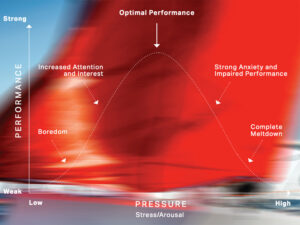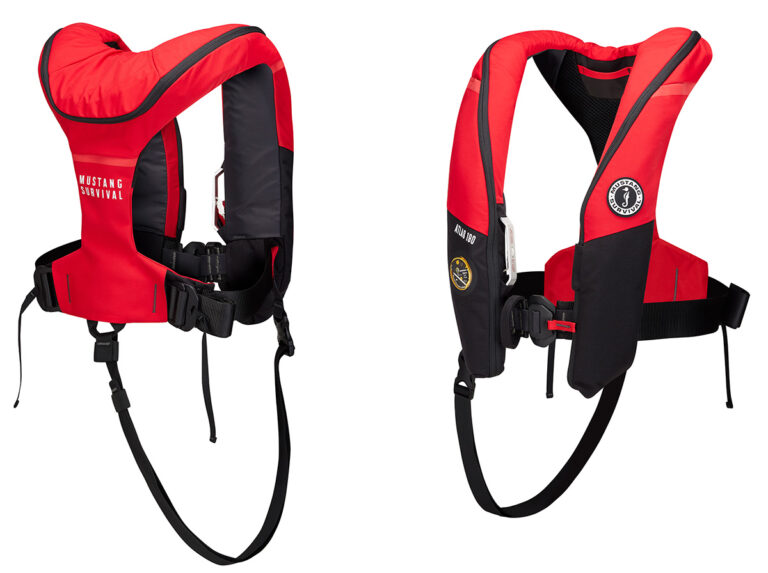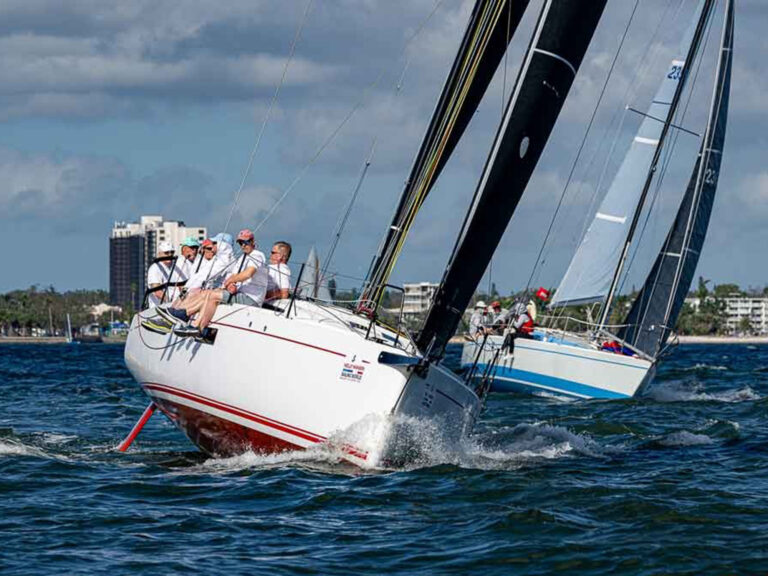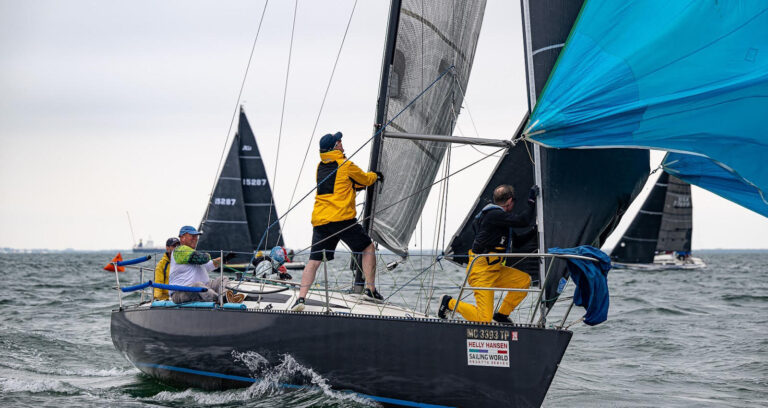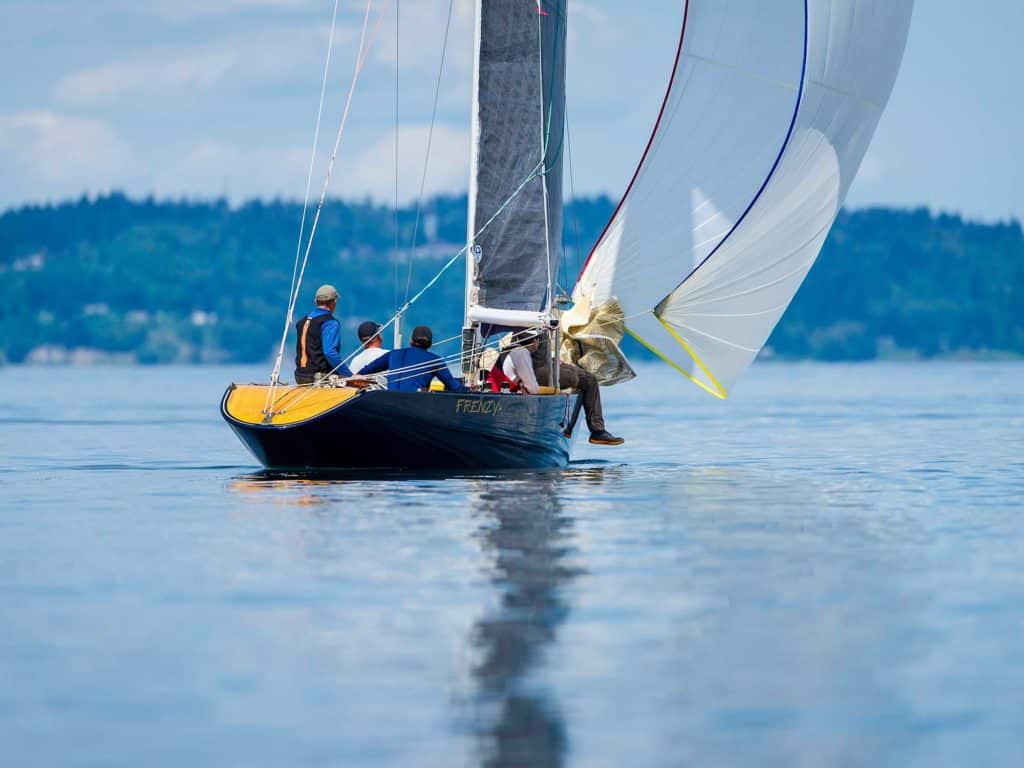
Lightning World Champion Bill Shore gazed out over a mirror-like racecourse before the final race of a past championship and said with a smile “Ideal conditions!” Considering that Bill was in a distant second at the time, and is known to prefer heavy air, that may seem to be a strange comment at first. But what Bill was thinking of is what all of us know too well: In light air it’s easier for the leader (or anyone else) to make big mistakes. Shore won the race and the regatta.
Light-air racing presents more than its share of frustrating moments, but it also provides more than the usual number of chances to get ahead of the fleet. A well-sailed boat can develop a great speed advantage; at times it can go literally twice as fast as its competitors—so it is not unusual to see the largest race-winning leads developed in the lightest of conditions. With good preparation and the ability to make your boat go fast in the smallest of zephyrs, you can put yourself in a position to take advantage of the abundant opportunities on a light-air race course.
Before you head out to the course, clean the bottom thoroughly and remove any extra gear from the boat. If you are confident the entire race will be sailed in light air, it may be a good idea drop some of the purchases out of the various block and tackle systems in your boat (especially the main and jib sheets) to make sail trim a little easier. Kevlar has made small-diameter sheets practical (and a real advantage). Boats the size of Thistles and Flying Scots can use sheets as small as 3/16″ or 1/4″ in all conditions; just be sure you have your gloves along.
Upwind Sail Trim
Good telltales are essential for light-air because you must know the exact direction of the wind at all times. Although many people use cassette recording tape, I’ve found that it flutters too much. Instead, unravel standard wool yarn and pull out the smallest diameter strands.
For telltales on the sails, be sure to use real wool; synthetic yarn will frequently stick to sailcloth due to static electricity. When low-wind velocities won’t actually lift a piece of yarn, smokers have an advantage. For those who don’t smoke, incense sticks are a great alternative as they can be taped on the shrouds and burn very slowly.
Even though the wind is moving much more slowly across the sails in light winds, sail trim is still very important for consistent boatspeed. The boat is always aching for more power and acceleration, so sail-trim guides are much different than in other conditions.
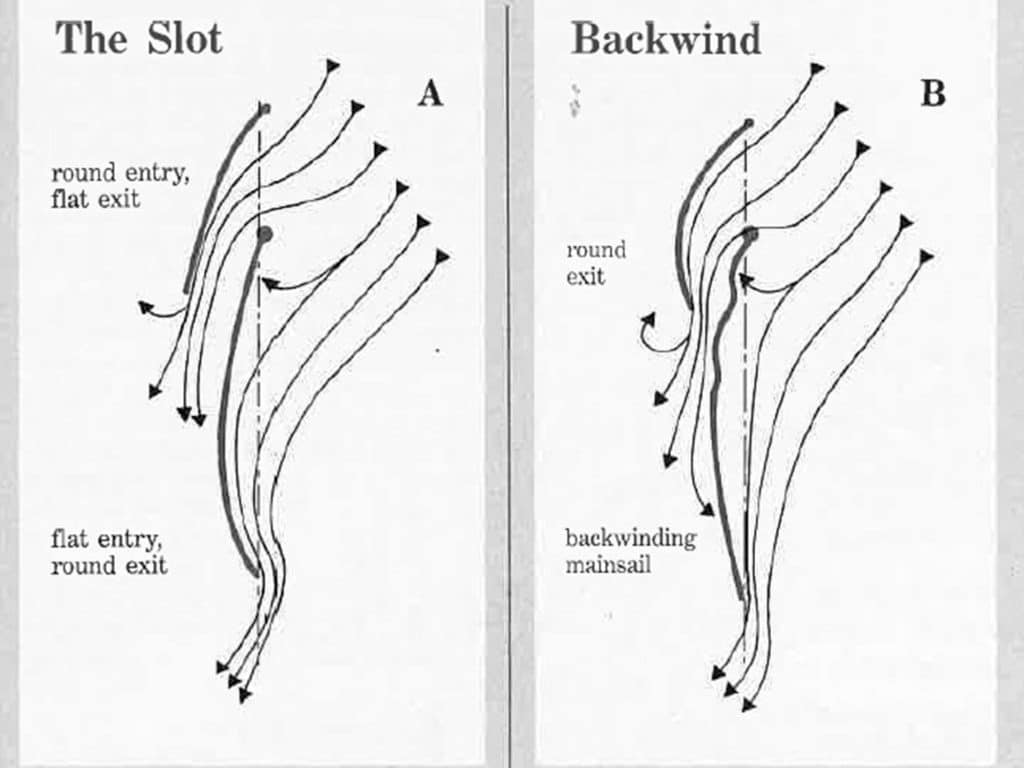
While one might think that a very full sail would be necessary to give the boat the power it needs, in most cases a flatter sail will perform better. The simple theory is that a full, baggy sail requires more “wind bending’‘; that is, the wind has to curve around the sail more, which gives the airflow more of a chance to break up and become turbulent. A flatter shape allows the airflow to remain attached, so leave the outhaul fairly tight to help the lower section of the main flatter and the leech more open. Pre-bend in the mast, if possible, can help flatten out the entry of the main. Another way to do this is to ease the cunningham, allowing the draft to move aft slightly.
In most conditions, the main is trimmed so the upper batten is parallel to the boom when sighted from underneath. In light winds, this is virtually impossible, due to the weight of the boom hanging on the leech of the main. It is not unusual for the mainsail leech to hook badly, sometimes as much as 10 to 20 degrees to weather of the foot. Although this looks bad, it is frequently beneficial to have the mainsail shape a bit rounder in the after sections. This will induce slight weather helm, and help get optimum pointing capability.
At no time should the leech of the main be angled farther to weather than parallel to the centerline of the boat. In drifting conditions, the technique of trimming the upper batten parallel to the boom is dropped, and the upper batten is set parallel to the centerline. In many cases, especially in boats where the boom is fairly high in the air, the boom is sheeted as much as two and a half feet to leeward of the centerline. It is important to realize that as soon as the wind picks up, the trim must be switched back to having the upper batten parallel to the boom.
The traveler goes through a similar transition: The traveler is sometimes pulled all the way to weather in super-light conditions so that the slightest puff will allow the boom to lift easily, but as the breeze picks up, drop the traveler down again so the boom stays at or below centerline while you are trimming the upper batten parallel to the boom. Another important area of concern for light-air sail trim is the slot. There isn’t anything slower in light air than having backwind at the luff of the main. With the main angled far off the centerline, the slot is in danger of being closed off. To avoid this, flatten the mainsail to pull the cloth out of the slot; this lets you ease the main until the upper batten is parallel to the centerline without backwind.
On the other side of the slot, the leech/exit of the jib must be open and fairly flat. Sometimes it is helpful to move the jib lead aft near to the heavy-air setting to open the leech and flatten the lower sections. In extremely light air, the weight of the sheet alone will hook the leech into the slot. Have a crewmember hold the jib clew up to keep the leech open. On most one-designs and on boats with tall, narrow jibs, it is not necessary to move the jib leads outboard unless there is a great deal of chop and the boat has to be sailed on a close reach just to keep it moving. On boats with shorter, wider jibs (longer LP), the jib lead should be moved outboard a couple of inches since there is a greater overlap between the jib and main.
The jib should become increasingly full in its forward sections. If you are sailing a one-design that uses the same jib in O to 30 knots of breeze, light air is the condition where the jib should be set up with the greatest amount of luff sag. A full entry is more powerful, and also helps widen out the “groove” so the boat is less critical to steer. It also allows the sail to tolerate abrupt changes in windspeed and angle without stalling. Go easy on cloth and halyard tension to keep the entry smooth as well; excess tension in the luff will make the entry too round, which produces a ‘‘knuckle” at the luff that disrupts the airflow.
Think of the jib and main not as two independent sails, but as a “combined foil’ Looking down from above at proper light-air sail trim, one would see a two-part foil that is fairly round and powerful in the front as well as the back. The middle sections should be flatter to keep flow attached. Imagine a jet at take-off or landing, with flaps down in front and back. As the jet picks up speed, the flaps are not required and are retracted.
Downwind Sail Trim
Off the wind, the mainsail doesn’t require as much flow across it as it does upwind, so a full shape, as mentioned earlier, will make it more forgiving. It is not necessary to have the outhaul pulled as tight, and mast bend should be eliminated. The jib should be set so that it looks like it does upwind. The crew should hold the clew outboard and up so that the leech is open and the jib not too full. The main should, again, have a round leech. Try to maximize the sag in the luff of the jib to make the entry more powerful, and keep both the cloth tension on the jib and the main cunningham eased. Although it would normally seem that a spinnaker would be a huge advantage whenever sailing downwind, the opposite is often true in light air. At any point of sail when the spinnaker should be developing flow across it (as in reaching), its full (and drooping) shape will actually slow the boat down. Instead, a tall, narrow, flatter jib can be a better alternative. It is not unusual for bigger boats to fly only a tall, lightweight staysail in drifting conditions. An exception to this would be when sailing dead downwind; there is no flow across the spinnaker, and the more area that can be projected, the better. A spinnaker, even if it is just drooping, should help the boat go a little quicker on a dead run. Adjust the pole height so that the two ends are even at all times. I like to have the pole-lift control placed alongside the guy cleat at the shroud so the crew can adjust both constantly. Always keep the spinnaker sheet well eased, since an over trimmed spinnaker will choke the slot. As with the jib/main slot, the slot between the spinnaker and the main must be kept free when reaching, especially since the spinnaker is so big and overlaps a large area of the mainsail. When sailing broader angles, pull the spinnaker around to weather as far as possible (keeping the pole perpendicular to the wind).
Light-Air Boathandling
Good teamwork is just as important as sail trim. Since the boat moves slowly in light air, any crew movement-particularly during maneuvers must be made slowly to retain the precious attached flow across the sails. Be sure the speed in which maneuvers are executed is much slower in light air. Keep in mind that the rules on kinetics are quite clear; the speed after the tack cannot be greater than the speed before.
Boat heel becomes critical in steering the boat upwind in light-air conditions. When you need to head the boat up, simply heel the boat to leeward, and when you want to bear off, flatten it out. If a puff gets to you, allow the boat to heel slightly so that weather helm will increase. This lets the boat slide up closer to the wind without using any rudder. When you get as high as you want to be, hike the boat flat (gently) to accelerate. If the boat is small enough so that one person can make all the changes in heel, allow the skipper to do so. He can feel the puffs and the load on the helm much more quickly than the crew, and can therefore react more smoothly. Keep the crew inside the cockpit whenever possible to reduce windage and keep the slot clear. Sail the boat on its lines with all weight concentrated in the middle of the boat, but heeled to get the proper weather helm.
Steering the boat downwind by means of heel is just as important. When trying to work to leeward, don’t be afraid of heeling the boat well to windward to induce a little leeward helm. This will help the boat slide to leeward without using the rudder. If there is enough wind to use the rudder to steer the boat, use it sparingly. Any time the rudder is turned, especially in light air, it acts like a brake.
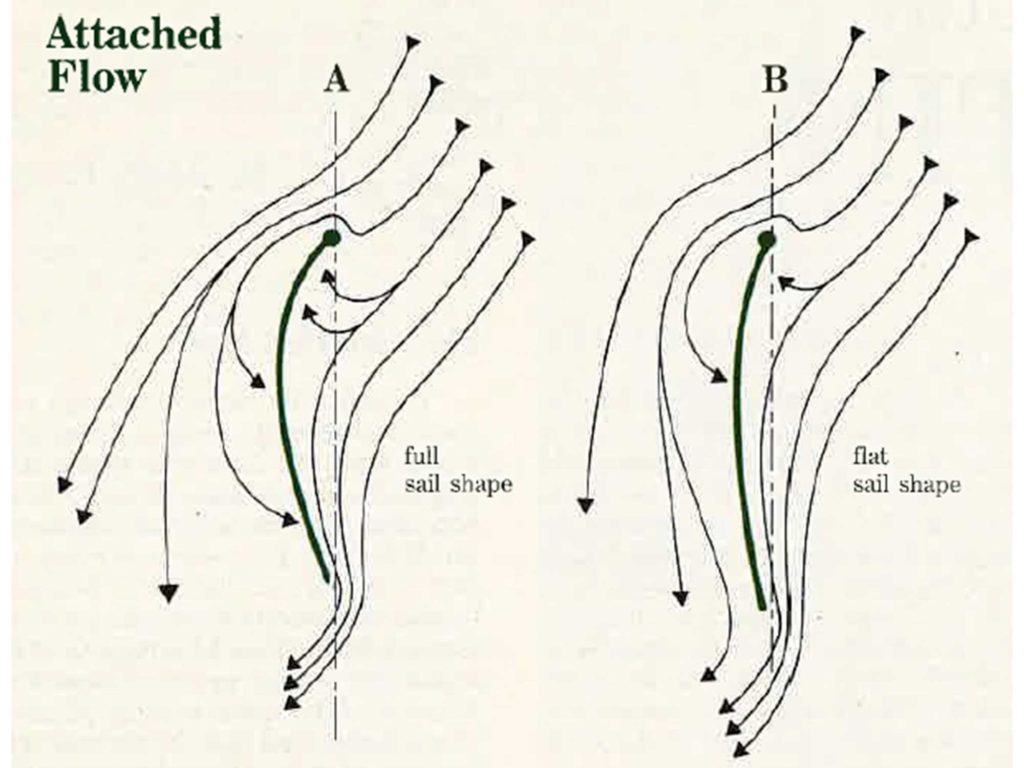
Also, when sailing in light air, the greatest differences in boatspeed occur upwind. Many people think that because they are sailing in flat water they can better point into the wind. However, until the wind reaches a certain velocity, the boat will not move fast enough for the blades to develop lift. Although it may seem your angle to the wind is higher, if the blades are stalled, the boat will simply slip sideways. Also, if the boat is sailed too close to the wind, the apparent wind moves farther forward and the boat stops. Instead, foot the boat off to keep it moving through the water and take advantage of the increased apparent. Wind from the additional speed. Even though it may seem that you are giving up distance to weather on the boats that are pointing higher, the speed you gain through the water will put you ahead. How far to bear off depends on the individual boat, but a basic rule of thumb is to bear off from your normal closehauled course more than you think you should, and then add another five degrees.
Tactical Considerations
Just as sail trim and boathandling are treated differently in light air, so are racing tactics. If you have good boatspeed, standard tactical situations should be approached aggressively in most conditions, but light-air tactics demand more conservatism and greater anticipation.
At the start, timing becomes critical. It is absolutely necessary for the boat to be moving at top speed at the gun. It takes time to accelerate to maximum speed, but once up to speed, it is actually possible to sail through the lee of a slow-moving windward boat and squirt well out in front. No matter what kind of boat, the approach to the start must be made in such a way that you maintain maximum speed. The final approach should be made on a clear, unobstructed path of adequate distance for the time remaining to build up the speed. The main priority for a light-air start is top speed, even at the expense of starting away from the favored end of the line. Depending on the degree of the advantage on the line, many times it is better to start at the unfavored end of the line simply to avoid traffic and to provide a clear runway to the final approach.
Top speed is still the priority after the gun, but to keep the speed up you must have clear air. Avoid tacking into a safe leeward position unless it is absolutely necessary, such as on the final layline to the weather mark. Not only is there danger of being rolled by the windward boat after the tack is completed, but you automatically forfeit the option of tacking. Being controlled by another boat severely limits your options. In many instances, you can actually gain distance when you dip a starboard tacker because of the speed you generate when bearing off. On the other tack, don’t be afraid to wave an approaching port tacker across if it looks like they might tack on your leebow to avoid you.
Because of the importance of clear air and top speed in light winds, avoid the middle of the course and the dirty air that boats to weather and ahead may provide. Look up the course and search for new wind, and predict which side of the course it will be on.
If a new wind comes in with more velocity, always sail to it as soon as possible, even if this requires sailing a headed tack to get to it. Since maximum boatspeed is extremely important, always aim to get in the position to increase speed through the water. Obviously, a massive shift would be an exception to this rule if the shift were to last a substantial length of time.
Tacking Angles
As soon as the breeze builds and the boat picks up speed, it should point closer to the wind. Remember that changes in tacking angles are not related to windshifts (unless the velocity changes are accompanied by a windshift), but are a result of the boat becoming more weatherly in an increased breeze. The crew reading the compass should be aware of the effect of the velocity on the tacking angles as well as the change in the compass readings. If you sail into a lull, the boat will want to bear off 10 degrees in what will appear to be a header to the compass reader. Since the change in angle will make the leeward boat look better, it may be tempting to tack and take advantage of the “header?’ After the tack, though, it quickly becomes obvious that the new tack is headed just as much as the old one. Sometimes the velocity will drop so quickly that the sails may actually begin to luff due to the apparent wind swinging so far forward. In this unusual condition, it may be necessary just to wait for the boat to slow down to match the hull speed with the wind velocity. Don’t be fooled by the luffing sails that you have sailed into a massive header; hang on for at least a few seconds to make sure that it is truly a header and not just a huge drop in velocity.
On the other hand, remember that an increase in velocity will show as a lift because the boat’s blades will gain efficiency as the speed picks up. On our boats we divide the responsibilities upwind so that one crew concentrates on the compass to pick out major shifts, while the other crew reminds him of the puffs and lulls.Although excellent boatspeed in light air surely helps, the key ingredient is the team’s mental attitude. Without confidence and the desire to be racing hard, there can be huge lapses in concentration. Since boatspeed is so low and tactics are accomplished slowly, every move must be anticipated. The crew’s eyes should be all over the course, looking for changes in wind velocity and direction.
Other boats should be watched for changes in angle which could also predict possible windshifts. Sometimes, when a shift or velocity change is missed (and not by other competitors, of course), you must work even harder to minimize losses. Don’t just let light air races happen; be smooth, but be aggressive. Take advantage of other competitors’ poor attitudes in these difficult conditions! An excellent attitude and practiced teamwork will lead you toward regatta-winning finishes.




